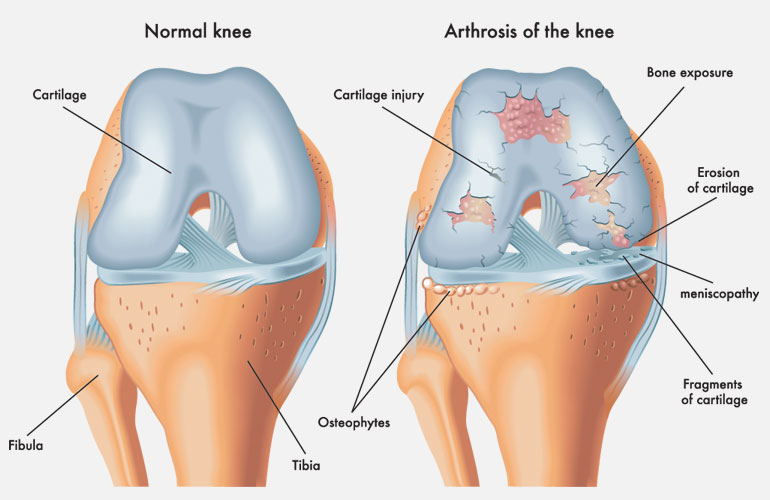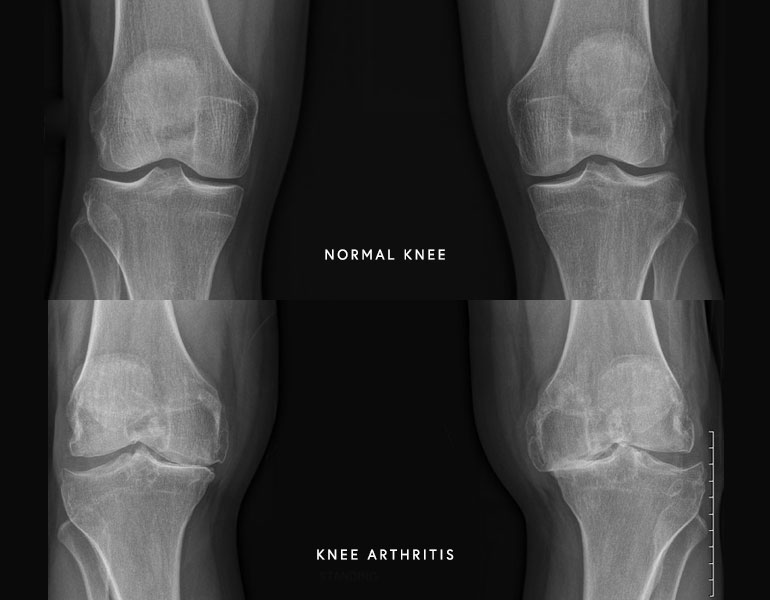Knee Arthritis
What is arthritis of the knee?
Arthritis simply means inflammation of the joint. While arthritis can affect any joint, the knee is one of the most commonly affected joints in the body. In fact, knee arthritis is the most common disease that Dr. Kelly and his team treat in the office.
What are the different types of arthritis of the knee?
Osteoarthritis
This is wear-and-tear arthritis of the knee that is associated with aging. It is by far the most common type of arthritis. The likelihood of arthritis increases with age, but we can see this in people in their 40’s and 50’s. In this type of arthritis, the cartilage (cushioning at the end of bones) becomes thin and sometimes completely erodes so that the bone surfaces are in contact with each other. This leads to pain and swelling for the patient.
Rheumatoid arthritis
This is an autoimmune disorder of the joints. Autoimmune disorders mean that the body’s own immune system mistakenly attacks the body. In rheumatoid arthritis, the immune system attacks the synovium, or the lining of the joints. This commonly affects the hands and wrists, but also the knee.
Post-traumatic arthritis
This type of arthritis is caused by a previous injury. If someone breaks a bone near their knee, or injures a ligament or other soft tissue around the knee, this can accelerate progression of arthritis. A common scenario is someone who reports an injury in high school football that was treated appropriately at the time of injury, but that person may end up with severe arthritis of that knee in 15-20 years.
What is basic anatomy of the knee?
The knee joint is composed of three different bones. The femur (thigh bone) rests on top of the tibia (shin bone). The patella (knee cap) glides on the front of the knee and helps to extend the knee. Many soft tissue structures around the knee serve different functions, but we will focus on the menisci. The menisci provide padding between the thigh bone and shin bone and help to distribute the stress in the knee evenly. Meniscus tears come in many different shapes and sizes but can be very troubling for patients. Lastly, there are four main ligaments that provide stability to the knee. The Medial Collateral Ligament (MCL) and Lateral Collateral Ligament (LCL) are on the inside and outside of the knee, respectively. The Anterior Cruciate Ligament (ACL) and Posterior Cruciate Ligament (PCL) are inside of the knee and protect against forward and backward shifting of the bones.
What structures are involved in knee arthritis?
The cartilage surfaces at the end of the femur and tibia wear out, similar to losing tread on a tire. Each of us have nerve endings in the bone so when we lose that cushioning, it can be quite painful.

What are symptoms of knee arthritis?
- Pain: this is often the first symptom. Patients most commonly describe pain with activity. For example, “I used to walk my dog for 2 miles every day but now I can hardly make it around the block.” Another common symptom is pain after a long period of inactivity.
- Swelling: When there is damage inside of the knee, the body naturally produces more joint fluid inside the knee. This swelling can be noticeable to the patient. Swelling is usually associated with achiness of the joint and pain in the posterior aspect (or the back) of the knee.
- Loss of motion: With severe disease, the knee can lose range of motion. This typically occurs late in the disease after many years of symptoms. Decreased motion in the knee makes it more challenging to walk, and also more difficult to perform daily tasks such as tying shoes.
How do you make the diagnosis of knee arthritis?

Dr. Kelly performs a thorough clinical evaluation of each patient that includes three major parts: history, physical examination, and imaging. The history is a focused conversation about duration of symptoms, location of pain, aggravating factors, and previous injuries or surgery to the knee. Next, Dr. Kelly will examine the knee focusing on the overall alignment, range of motion, and any areas of swelling or tenderness. Finally, x-rays of the knee are reviewed which provide additional information about the health of the knee joint. In most circumstances, advanced imaging such as an MRI is not required to make the diagnosis of knee arthritis.
What are the treatment options for knee arthritis?
Non-operative treatment
In almost all scenarios, Dr. Kelly provides non-operative treatment options for a patient with knee arthritis. This typically includes a combination of anti-inflammatory medication or gel, physical therapy, and some type of injection. See “Non-operative Treatment of Knee Pain” for more details.
Partial Knee Replacement
If only one area of the knee has arthritis, a partial knee replacement is an excellent option. The medial (or inside part) partial knee replacement is the most common followed by patellofemoral (knee cap) and lateral (outside) partial knee replacement. See “Partial Knee Replacement” for more details.
Total Knee Replacement
In a total knee replacement, all of the cartilage surfaces are removed and resurfaced using a metal implant. A medical grade plastic tray is inserted so the metal implant rubs on the plastic liner. See “Total Knee Replacement” for more details.
At a Glance
Dr. Mick Kelly
- Board-Certified Orthopedic Surgeon
- Fellowship Training in Hip and Knee Replacement
- Author of medical publications and numerous textbook chapters
- Learn more
